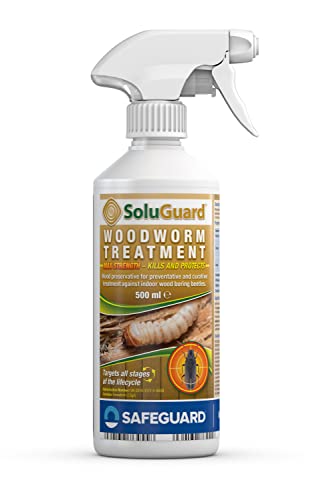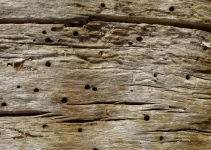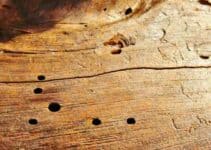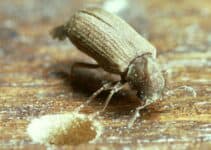One of the most common pests that affect parts of a house (floorboards, joists etc) or wooden furniture is woodworm. These tiny little nuisances are the larvae of various species of woodboring beetles, and they can cause a lot of damage to furniture and other wooden items in your home.
It is important to tell if woodworm is active to take the necessary steps to get rid of them. It is a simple enough task and does not cost a lot of money to get rid of them if done at an early enough stage. But how do you tell if woodworm is active? You can tell woodworm is active when you can visibly see a powdery grass on the timber, this commonly looks like sawdust.
Read on to learn how to tell if woodworm is active in your home.
How To Tell If Woodworm Is Active In Furniture
There are a number of ways to tell if woodworm is active in furniture. The first sign of a woodworm infestation is usually the emergence of small holes in woodwork from which fine dust (known as “frass”) falls out.
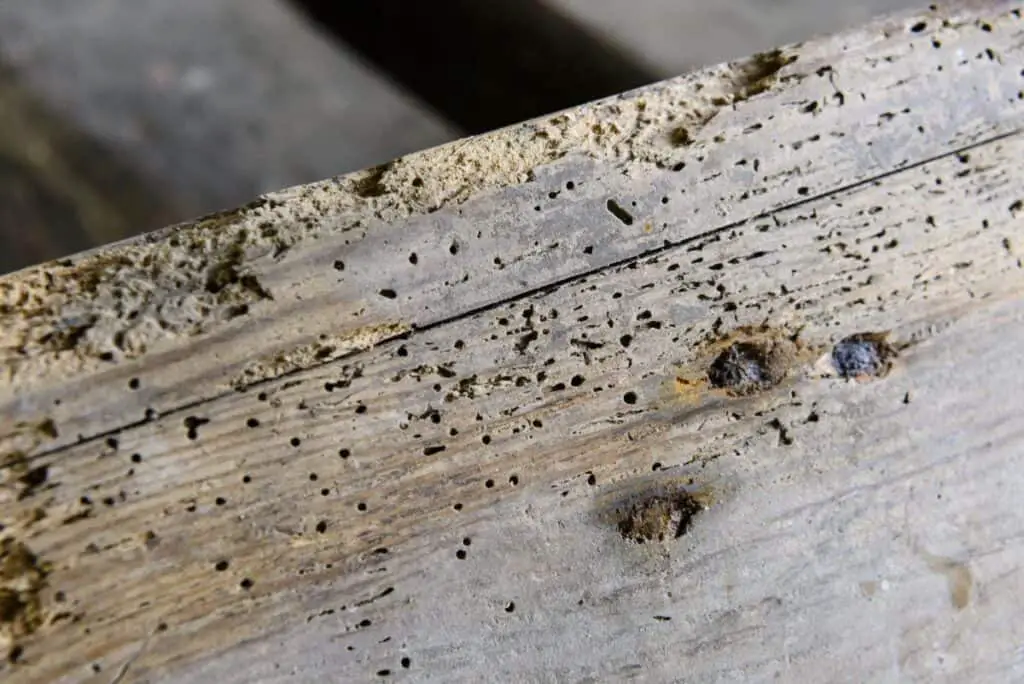
The presence of this frass indicates that an active infestation is present and this will cause damage if left untreated for long periods.
Woodworm holes are easier to spot on light furniture but often harder to see in dark timber. If you have a magnifying glass, use this to inspect the grain and look for holes with dust around them, which would indicate that the woodworm is currently active.
Another sign that woodworm is active is if you see powdery dust coming from the active woodworm holes. This is woodworm excrement, and it means that the larvae are currently feeding on the wood.
Another way to tell is by tapping the wood with a small hammer. If the wood sounds hollow, it indicates that there could be large holes that are not meant to be there inside the piece.
Also, look for tiny piles of dust on the surface or at the base of any piece of furniture and see if there are fresh holes or tunnels in them. If new holes appear in your furniture over time, this indicates that new beetles are hatching and boring into the furniture. This means that the infestation is still active.
Use this easy treatment to spray onto your wood to end an active infestation:
Also, you may notice fresh sawdust around your furniture, and this is a sign of an active infestation. The larvae bore through timber and create mounds of sawdust as they eat their way through the furniture.
Some woodworm beetles require high humidity to survive, so they will create mud tubes on the timbers. These tubes are made from soil and wood dust and provide the moisture needed for the beetles to thrive.
Sometimes you may see live adult beetles emerging from the timber during periods in spring and summer when they are most active (generally May to September). These adult beetles are attracted to light and fly towards windows and doors during daytime hours looking for a mate.
Inactive Woodworm
Inactive woodworm is not uncommon, and it is usually found in older properties. So, how can you identify inactive woodworm, and what are the steps to take next?
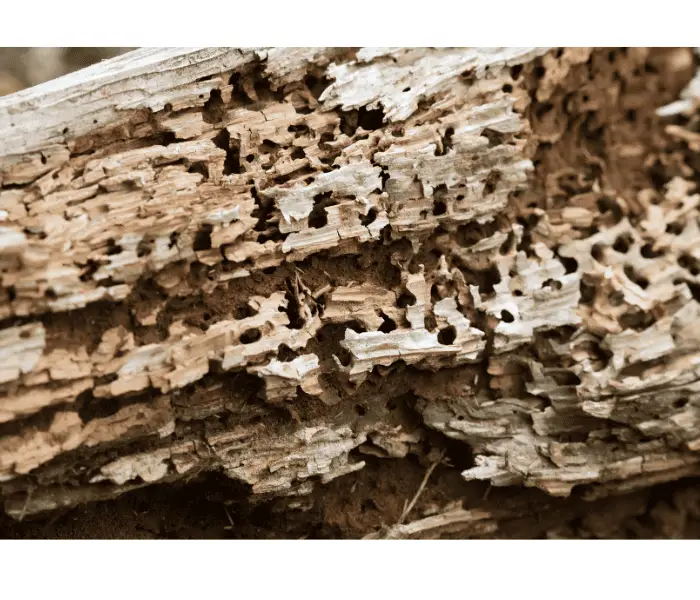
What Is Inactive Woodworm?
Inactive woodworm is the term used to describe a situation where the beetles have emerged from the timber, leaving behind empty egg cases (commonly referred to as ‘flight holes’), but there are no further signs of infestation.
Many older houses will also have been treated for woodworm at various times over the years, so the woodworm signs of old and empty holes where they have once been should not be of concern in and of itself (all else being equal) although it would be wise to thoroughly check joists etc for historical structural damage that could have easily been covered over or that the homeowner may be blissfully unaware of.
It is possible to confuse flight holes with exit holes left by other types of insects, such as carpet beetles. To tell the difference, carpet beetle exit holes have a slightly rounded appearance, whereas those made by wood-boring beetles are almost always perfectly circular.
Signs of Woodworm
Some woodworm infestations can be challenging to identify as the woodworm beetle may have been active for many years, resulting in the damage and holes made by the woodworm beetle being filled in by a previous owner. Not identifying these early woodworm signs and stopping the woodworm spreading can lead to bigger problems.
Locating and identifying inactive woodworm is an important part of any property survey. If you are unsure whether you have had a previous woodworm infestation or not, it is worth inspecting your property with a professional to ensure that there is no remaining danger.
It is important to note that not all flight holes are created equal.
Certain characteristics can help you determine if the woodworm has indeed emerged from the timbers:
Powdery Frass
Emerging larvae push out a speck of powdery dust, known as frass, from their burrows as they tunnel through the timber. If you find piles of powdery dust near flight holes, then you can be sure that this indicates an active infestation.
No frass – if there is no frass around the holes and the wood feels solid, it is likely that the woodworm has already vacated the timber.
Round Exit Holes
As mentioned earlier, the exit holes made by woodworm are usually perfectly round. If you see holes that are not quite round, then it is likely that another type of insect has caused the damage.
Check The Surrounding Area
In some cases, and you may find evidence of an active infestation even if there are no flight holes present. This may include evidence of larvae feeding (such as small piles of dust), new holes being created, or the beetles themselves.
FAQs
How do you Know if Woodworm is Active?
Inactive woodworm is when the woodworm beetle has emerged from the timber, leaving behind empty egg cases, but there are no further signs of infestation. If you find piles of powdery dust near flight holes, then you can be sure that this indicates an active infestation.
Active Woodworm Holes – What do they look like?
Active woodworm holes made by woodworm are usually perfectly round, and you may find evidence of an active infestation even if there are no flight holes present.
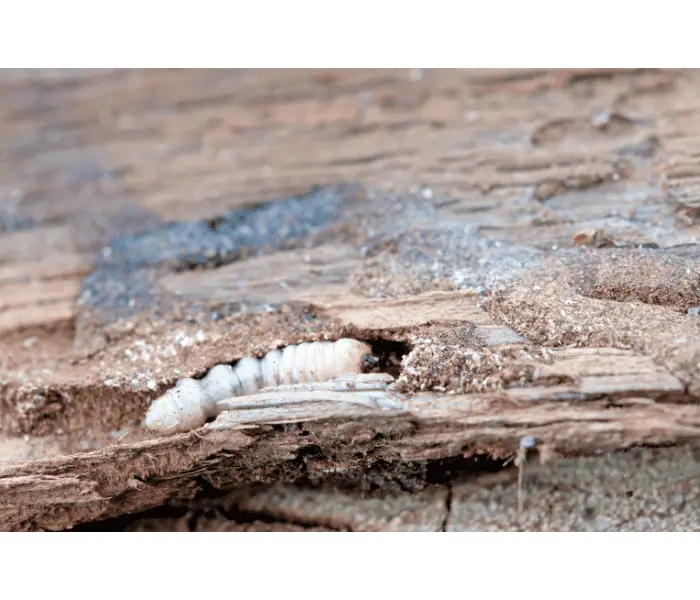
How to Tell if Woodworm is Active – What to Do Next
If you believe that you have an active woodworm infestation in your home, while there are woodworm fixes (e.g. insecticide and gels etc) on sale in many DIY stores. You can get woodworm treatment like this one here. If applied every 6 months it kills active woodworm and stops any continued damage to the beams:
Woodworm can cause significant damage to timber if left untreated and the extent of the infestation may not be immediately apparent to untrained eyes.
If it is just is one piece of furniture, then you can easily treat it yourself.
What Conditions Do Woodworm Like?
Woodworm thrive in damp, poorly ventilated conditions. This is because high humidity and moisture allow the larval stage of the beetles, which is responsible for the wood damage, to persist and burrow more efficiently. Moreover, they prefer soft, untreated woods like pine, especially in older properties. Certain species also tend to target hardwoods like oak.
Over time, a sustained level of moisture can lead to structural weakness in affected wood. Therefore, maintaining dry, well-ventilated conditions and treating wood with appropriate products can deter woodworm infestation.
Are Woodworm Attracted to Light?
Woodworm is not attracted to light. This is because their life cycle and feeding behavior are typically confined to the dark, damp interiors of wooden structures, where they can eat and grow protected from predators and environmental factors.
They primarily feed on the cellulose contained in wood, a food source that does not require light to find.
Their natural behavior is adapted to low-light conditions, making light neither a necessity nor an attraction for them. In fact, exposure to light could make them more visible to predators.
Consequently, woodworm activity isn’t influenced by light but rather by the availability of suitable wood in which they can live and feed undisturbed.
Thus, woodworm infestations are usually identified not by the insects seeking light but by the visible damage they cause to the wooden structures they inhabit.
